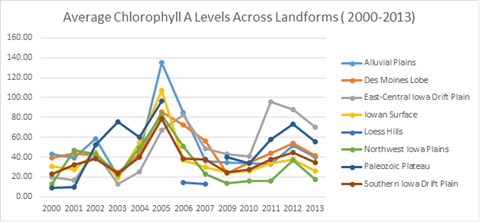Some of our recent work is about water quality in Iowa lakes. Iowa has more than 200 lakes spread over diverse geographic areas. The Clean Water Act says that each state, including Iowa, must specify appropriate designated uses to be achieved and protected. The Iowa Department of Natural Resources has proposed rules that establish a numeric nutrient water quality standard to protect recreational uses in certain lakes in Iowa. Eco-regional differences in water quality parameters across Iowa is one thing that must be accounted for in the development of nutrient criteria for Iowa lakes. Previous studies in this area have shown distinct regional patterns in lake productivity associated with regional differences in geology, vegetation, hydrology and surrounding land use.
Our analysis is based on data collected by Iowa State University in 126 reference lakes between 2000 and 2013. Lakes were classified into 8 ecoregions. Average Chlorophyll-A levels in the sampled Iowa lakes varied from 28 µg/L in 2000 to 36 µg/L in 2013. Average Secchi depth in the sampled Iowa lakes varied from 1.05 m in 2000 to 1.12m in 2013. The ANOVA technique was used to test the differences among the mean levels of Chlorophyll-A and Secchi depth across ecoregions. We find that both Chlorophyll-A means and Secchi depth means differed significantly across the lakes in the eight ecoregions.
We also find that Chlorophyll and Secchi depth show a large variation across ecoregions and their distributions are skewed. Nonparametric tests were done to test the differences among the populations (medians) for both Chlorophyll and Secchi depth. Wilcoxon Z statistics are calculated to compare the differences in medians across the ecoregions. Both Chlorophyll A and Secchi depth show statistically significant differences in populations in the lakes across the eight ecoregions.
With the observed parametric and nonparametric differences in lake water quality parameters among ecoregions in Iowa, we firmly believe that the proposed uniform state-wide standards lack the necessary statistical validity to be used for regulation.


